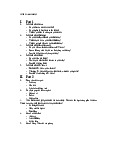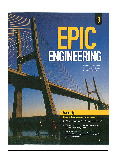














Preview text:
B1/B2 Multilevel Exam
Sample Tasks for Reading Comprehension
B1/B2 – Reading Comprehension Sample Tasks
1. B1 level - The Importance of Music in Schools
Read the text below and complete the sentences with a maximum of 4 words. Record your
answers on the answer sheet. The first one (0) has been done as an example for you. The Importance of Music in Schools
"Music helps the mind develop and grow," my dad often says, and I have found this to be very true.
It is a proven fact that participating in a music program in school will help develop your brain to a
higher level and faster than other students. Music actually improves communication between the right
and left sides of the brain, allowing you to gain better comprehension and memorization skills.
So, why do we need music in our schools? Well, because music is everything.
Music is science. It is exact and demands acoustics. The conductor's score is a graph that
contains volume changes, melody and harmony, all the while keeping the group at a constant pace.
Music is math. It is based on the rhythmic subdivisions of time, done in a split second.
Music is history. The music you hear or play is usually an indication of the time and environment in which it was created.
Music is physical education. It requires an immense amount of coordination of fingers, hands, arms,
lips, cheeks and facial muscles. Not to mention control of your diaphragm, back, stomach and chest
muscles to make sure every note comes out clearly and in pitch.
Music is a foreign language. Its terms are usually in Italian and the music is not in any language known
to man. It is its own language and uses symbols to represent ideas.
Music is the universal language that everyone understands and can relate to. Music is what brings everything together.
Most of all, music is art. It is the greatest form of art that allows a human to take boring notes on a
page, and transform them into an emotion and feeling you cannot measure.
Music is just as important as all the classes you are required to take, and it is critical that music
classes remain in schools. Not only to provide a place for students to belong, but also something that
will help their minds grow and develop like no other class. http://www
.teenink.com/opinion/all/article/10083/The-Importance-of-Music-in-Schools / 1
B1/B2 – Reading Comprehension Sample Tasks
Complete the sentences with a maximum of 4 words.
1. A number of mental skills get better if you go to a music program in school .
2. Music has elements that change or stay the same, comparing it to…
3. Music is a reflection of when it was composed, it can be related to…
4. Sport and music both need a lot…
5. Because music communicates ideas it can be compared to a…
6. Musicians create art by reading…
7. For many reasons, music lessons should…
B1/B2 – Reading Comprehension Sample
2. B1 level – My Holiday in California
Read the story below and complete the text with the correct phrase. Mark the correct answer on your
answer sheet. There are two phrases you do not need to use. The first one (0) is given as an example. A. went to Hollywood B. couldn't go on C. had delicious D. was closed E. had lots of stars F.
stayed at our Grandpa's house G. had really big H. was this really big wave I. loved the food there J. was really cool My Holiday in California
At the end of May we went to California in America. We stayed in the Hotel Irvine for four days which
was a brilliant hotel and then we (0) F _ for a week which was also really cool. Grandpa has a cool
house and he also has the Disney Channel, which we loved!
The first couple of days, we went to Del Taco. This is a Mexican restaurant like you've never seen
in England before. It has tacos, quesadillas (the soft ones) and it also has burritos. Del Taco was
my favourite place to eat because it (1)
Mexican food. We also went to Rubio’s (king of
the fish taco) which is another Mexican restaurant. My sister BooJam went to a sandwich place
called "Which Witch" and she (2) .
We went to Knottsberry Farm and I went on the Jaguar rollercoaster ride. My sister
(3) because she was too small. The queuing was very scary because it was in an
Egyptian tomb, but the ride was really good. One of the rides (4) . It was a ride where
you got to lie down and fly in Camp Snoopy. I loved it and so did my sister too. We also went on a
ride where we bounced up and down and that was so much fun.
We (5) to look around. Our tour guide was Grandpa. We saw the Hollywood Sign, Mann’s
Chinese Theatre, the handprints in the concrete on the floor and the Hollywood Walk of Fame which (6)
on the floor. I saw the handprints of Daniel Radcliffe, Rupert Grint and Emma Watson. 3
They are my favourite characters from Harry Potter.
Los Angeles has lots of swimming pools. We went in a swimming pool with diving boards and had
lots of fun swimming around and diving.
We went to Newport Beach and I was swimming in the sea and there (7) and I had to cling
onto the sand as the wave washed over me. It really hurt but it was also cool at the same time. We also
bought necklaces for each other.
http://betsylouadventures.blogspot.com.es / 0 F 1 2 3 4 5 6 7
1/B2 – Reading Comprehension Sample 3. Oceans of plastic
Read the article below and complete the text with the correct phrase. There are two phrases
that you do not need to use. The first one (0) is given as an example. Write your answers on the answer sheet. A has ever been made B are thrown away C
have been dumped in the oceans in 2010 alone
are tiny fragments of plastic that have been broken D up E
less rubbish ends up being thrown into the sea F
has discovered plastic bags everywhere G
finds its way into our oceans every year H
has been collected there by the currents I
more dangerous than disposable bottles J
more than had originally been thought Oceans of plastic
Scientists from the USA's University of Georgia have released details of their recent study into how
much plastic rubbish (0) G. The new findings were released at the American Association for the
Advancement of Science's annual meeting. The amount of plastic reaching the oceans each year is
staggering at around eight million tonnes. Dr Jenna Jambeck, who led the study, said that this is "equal
to about five plastic bags full of plastic for every foot of coastline around the world." Eight million tonnes
of plastic per year is actually about the midrange estimate for the study, with a range of 4.8 milllion
tonnes to 12.7 million tonnes estimated to (1) . The study has also estimated the total amount of
plastic in the world's oceans, which is somewhere between 20 and 2,000 times (2) .
China is the top plastic dumper, throwing around a million tonnes of plastic rubbish into the sea by itself.
This is partly because of its huge population, but also because so many of its people live along its 5
1/B2 – Reading Comprehension Sample
lengthy coastline. The European Union, taken as a whole rather than as individual countries, comes in at number 18.
Plastic once it has been made does not rot away. That means that all of the plastic that (3) is still
in existence on our planet's surface. In the sea, it gradually breaks up into smaller and smaller pieces,
but it doesn't completely disappear. Ocean currents cause huge areas of plastic rubbish to form in
specific places. For example, the Great Pacific Garbage Patch, which covers an area of ocean roughly
twice the area of France, is a mass of floating plastic waste that (4) . In some places, it can be up
to 10 metres deep! There are already beaches on Pacific islands that are covered in multicoloured
sands. When you look closely at the blue, yellow and red grains of sand it becomes evident that they are
not sand at all. Instead, they (5) and washed ashore by the action of the seas.
If we don't do something, the study predicts that by 2025, some 17.5 million tonnes of plastic may find its
way into the oceans in that year alone! That would mean 155 million tonnes more plastic in the oceans
between now and then. Some countries need to look at how they manage their waste in the coming
years, so that (6) . In developed countries, we need to stop the wasteful practices like using
disposable plastic shopping bags. Most supermarket carrier bags for example have a useful life of just
20 minutes before they (7) and we use billions of them every year in the UK alone.
You can find some great suggestions for how we can deal with this problem in a brilliant animation
produced last year by the children of Ollaberry Primary School in Shetland. With their film, they became UK Champions in the T otal Green School Awards 2014.
Taken from: http://ypte.org.uk/news/oceans-of-plastic 6
B1/B2 – Reading Comprehension Sample 4. Three wild animals
For each question 1 – 8, choose from the animals described in A, B or C. You can use the
letters more than once. The first one has been done for you as an example (0). Be sure to
write your answers on the answer sheet. Three wild animals A. Robins
The robin is, without doubt, one of our favourite garden birds. It seems
to trust us, staying close when we’re in the garden and even taking
food from our hands. This confiding nature has existed for many
centuries – the first record of a robin taking food from a human was in the 6th century. Seeing red
The robin’s red breast is part of what endears it to us, providing a
welcome flash of colour on a winter’s day. But its evolutionary
purpose is for a more serious role, with male robins using it to settle territorial disputes,
especially during the breeding season. In some populations, up to 10 per cent of adult
mortality is due to clashes over territory. This is the reason why robins are born without a
red breast, and don’t acquire it until their first moult. Unusual nesting habits
Robins are prolific breeders, often producing between three and five broods a year, each
containing four or five eggs. If the weather is mild, they can breed as early as January,
though it is more usual for them to start in March. Broods can overlap with the male
feeding the chicks of one clutch while the female sits on the eggs of the next. This enables
the population to bounce back readily from any overwinter population losses.
Robins will nest almost anywhere. Recorded nest sites include plant pots, a pigeonhole in
a desk, the engine of a WWII plane, and in the body of a dead cat. Street singers
Robins are one of the first birds to start the dawn chorus
and one of the last to stop singing at night, even in the
winter when they sing to defend their winter territories. B. Grey squirrels
Grey squirrels are a common sight throughout much of
the eastern United States and Canada. These small,
tree-dwelling rodents fit easily into a number of habitats
due to their remarkable adaptability. Grey squirrels
are easily recognized by their grey coat (varying from yellowish gray to pure silver, though
different color morphs exist), ruffed tail and cream-coloured underbelly. 7
B1/B2 – Reading Comprehension Sample
Grey squirrels provide a source of food for many predatory species within their habitat,
including many birds of prey (eagles, hawks, falcons, owls and ospreys), weasels, foxes,
coyotes, wolves, bobcats and lynxes. They are also hunted by humans for population
control, sport or food throughout much of their range. Grey squirrels predominantly feed on
tree nuts, but will also eat flowers, seeds, fungi, insects and even the occasional bird eggs.
In addition to serving as an important prey species, the nut storing tendencies of the grey
squirrel help to disperse tree seeds within their habitat. Adaptability
Grey squirrels have been able to adapt to a number of habitats, as their native
environments have become more urbanized and forests cleared. Though they require
trees for nesting, squirrels will occasionally make use of outside leaf nests, eaves and
attics, allowing them to thrive in suburban and urban areas, and areas without heavy forest
cover. Because grey squirrels have a relatively flexible diet (and because acorns--a very
common nut in many yards and parks--are a large part of their diet), they are able to
further adapt to changing environmental conditions. C. Mice
A mouse is a small rodent with a pointed nose, furry round body, large
ears and a long, often hairless, tail. There are hundreds of types of
mice, divided into subfamilies of either Old World or New World
species. Common varieties include deer mouse, house mouse, field
mouse, wood mouse, dormouse, spiny mouse and zebra
mouse. Though some people talk about mice and rats as if they were the same thing, they
are actually different types of animals in the rodent family. Rats generally are larger than
mice, and they can be bald, scaly and cylinder-shaped. Size
Mice come in a wide variety of colors and sizes. Some common mice colors are white,
brown and grey. Some are very tiny and others are around the size of a baked potato. Where do mice live?
Mice are hardy creatures that are found in nearly every country and type of terrain. They
can live in forests, grasslands and manmade structures easily. Mice typically make a
burrow underground if they live out in the wild. Their burrow helps protect them from
predators. Their natural predators are cats, birds, wild dogs and foxes.
Mice are nocturnal, meaning they like to sleep during the day. This is why house mice can
be heard playing or foraging during the night. Most wild mice are timid toward humans and
other animals, but they are very social with other mice. According to the , RSPCA mice are
very territorial. Even domestic mice like to have a large area that they can claim as their own. 8
If you believe what you see in cartoons, you would think that mice eat cheese. Actually,
they like to eat fruits, seeds and grains. They are omnivorous, which means they eat both
plants and meat, and the common house mice will eat just about anything it can find. In
fact, if food is scarce, mice will even eat each other. Mice have voracious appetites. They
eat around 15 to 20 times per day, so they build their homes nearby places that have
readily accessible food sources.
According to the texts, which animal/s…
choose their homes to protect them from attackers. 0 C are sometimes eaten by people. 1
can be comfortable around people. 2
change their colour as they get older. 3
have been known to eat members of their own species. 4 are active both night and day. 5
have to make their nests in trees. 6
help increase the number of trees. 7
recover easily from a decrease in numbers. 8
http://www.discoverwildlife.com/blog/everything-you-need-know-about-robin
http://animals.mom.me/habitat-grey-squirrel-1529.htm l https://www
.livescience.com/28028-mice.htm l
4. B2 level - Teen millionaire
You are going to read an article about a social media site for girls. For questions 1-6, choose the
answer (A, B, C or D) which you think best fits according to the text. Here is an example (0). Example:
1. What do we learn about Miss O and Friends in the first paragraph?
A. It made a big profit in 2005.
B. The cool girls were based on Juliette’s school friends.
C. Proctor & Gamble put $15 million into the site.
D. Juliette created the cool girls years before starting the website. Example: 0. D
How a 16-Year-Old Girl Started a Multimillion Dollar Social Network By T een Kids News
1. Juliette Brindak started a social networking site for tweens when she was 16, and it’s doing
better than ever. Miss O and Friends generates 10 million monthly visits, a twenty-fold increase
from its inception in 2005. It’s also worth around $15 million, according to early investor Procter
& Gamble. When she was ten, Brindak drew characters for a set of five friends she called “Cool
Girls,” who were all inspired by real-life girls. The main cool girl, Miss O, represents her younger
sister Olivia. The set of “Cool Girls” would eventually become “Miss O and Friends.”
2. In the beginning — like many startups — Brindak reached out to family members and friends for
investment money. Her mother, a graphic designer, brought her drawings to life while her father,
who has a background in business, aided in the fundamentals of creating the company. What
started out as a few sketches on the way home from a family vacation quickly ballooned into a
haven for millions of adolescents. The site was ranked the third largest girls-only Web site in
2011, according to Inc. Magazine.
3. Now, at 23, Brindak isn’t as in tune with what tween girls are looking for, so she uses the site as
an avenue to understand their needs. Through polls, quizzes, and the “Girl2Girl” wall, members
are able to keep Brindak updated. “In November 2011, girls were writing on the Girl2Girl wall
asking if we could get them tickets to a One Direction concert. This was the first time we ever
heard about One Direction and we were able to create a concert/sponsorship with Simon &
Schuster’s ‘Dork Diaries’ books and winning tickets.” She’s made it possible — through contests
— for her users to see celebrities, such as Justin Bieber, Miley Cyrus and the Jonas Brothers, in
concert. Currently, she’s offering an all-expense paid trip to Canada for four lucky fans to see Taylor Swift’s show.
4. Through high school and college, the site has continued to improve. When it was originally
launched, there was little more than a few catchy graphics. “There was a homepage, which had
the five Miss O characters and simple flash animations,” Brindak says. “There was hardly
anything to it, but it was definitely a start.” Now the site boasts message boards, quizzes, games, music, and more.
5. But managing the site as a college student at Washington University in St. Louis was no easy
task. “One teacher, who ironically was an entrepreneur and taught my class on social
entrepreneurship, was the only one who wouldn’t budge about dates. I had a final on the same
day I had to fly out to California for a really important meeting and he said that if I missed it, I
would get an entire letter grade taken off my final grade. Luckily, the meeting got moved, but I
was so shocked about his reaction.”
6. Instead of the typical business majors most entrepreneurs study, Brindak decided to focus on
Anthropology and Public Health because her site revolves around women’s health issues. “I
was able to learn so much about cultures around the world and also become informed and
aware about different ways that I can reach out to women,” Brindak says. “The goal for the site
was, and still is, to help young girls build confidence and self-esteem.”
7. To share her users’ stories with the world, Brindak published the book Miss O & Friends: Write
On! The Miss O & Friends Collection of Rockin’ Fiction, a compilation of user-submitted stories.
Brindak tells us she plans on publishing more books in the near future. “We started off with a
business plan that we have used as our guide, but that business plan is always changing. We
continue to find new ways to engage girls, to generate revenue, and new outlets that are
appropriate for Miss O and our community.”
https://teenkidsnews.com/tkn-news/careers/how-a-16-year-old-girl-started-a-multimillion-dollar-social-network /
1. When the website first appeared…
A. It included photos of Juliette’s family.
B. Only two sites for girls had more visitors.
C. It needed some financial help.
D. Juliette’s parents gave up their jobs to help her.
2. What do we learn in the third paragraph?
A. Members provide information to help the site stay relevant.
B. The website now sells tickets for musical events.
C. Juliette was a fan of One Direction.
D. Site members can pay to meet famous singers.
3. How is the site described in paragraph four?
A. It’s quite basic, but is getting better.
B. There is a wide range of elements.
C. The original cool girls now sing.
D. It was more difficult to make in the beginning.
4. What do we learn about Juliette’s time at university?
A. She found her exams difficult to pass.
B. She had to cancel a business trip because of an exam.
C. She was surprised by a teacher’s reaction.
D. Some teachers were unhappy she was working and studying.
5. How did she decide on her degree subject?
A. Her ambition was to work in the health system.
B. It was typically chosen by business people.
C. She wanted to travel and work in other countries.
D. She thought it was relevant to the aims of her website.
6. What does Juliette say about the future?
A. She wants to write another book.
B. The site will follow the original design.
C. She would like to encourage more international contributions.
D. She hopes to promote her members’ writing. 0 D 1 2 3 4 5 6



